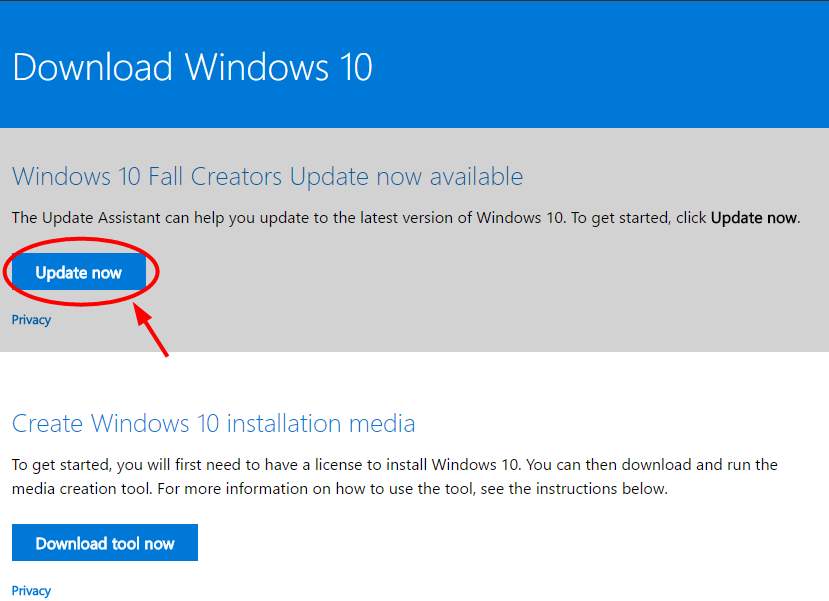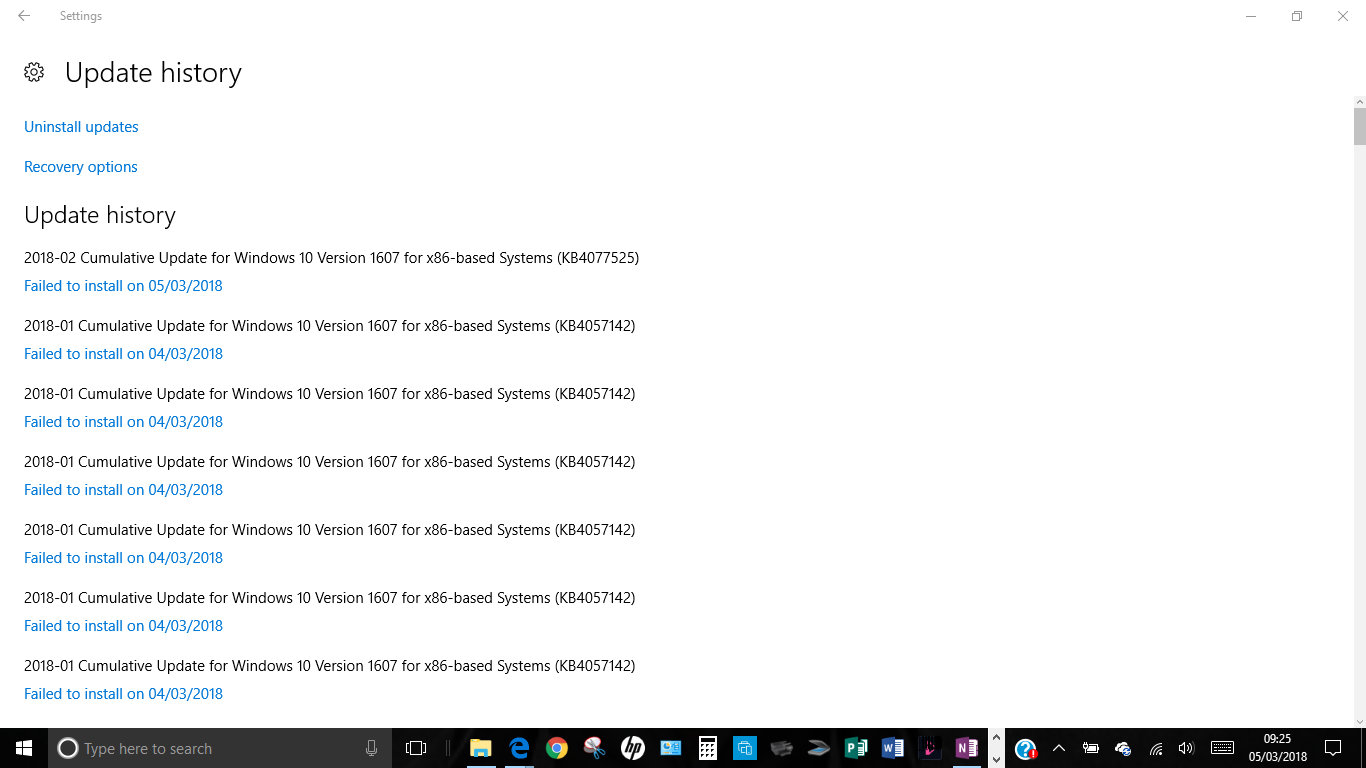Failed To Install Windows 10 Version 1607
Failed To Install Windows 10 Version 1607 Rating: 6,6/10 8336 votes

- Recently, Windows decided to release an Anniversary update namely 1607, for its Windows 10 version. But, as per the reports, many Windows users have been facing this trouble where they are unable to install the update. What happens is that the operating system attempts to update version 1607 but it fails.
- Windows 10 feature update to version 1607 failed to install several times,now is it better to wait for Microsoft to solve the problem? Or to use the ' media creator ' to update with the risk of.
- Along came 1607 anniversary update and screwed my computer up so bad that I tried a reset this PC only to find out it would not reset! I used Linux to boot the computer grabbed my files and pictures then I wiped the cursed windows 10 off my computer and reinstalled windows 7.1 and the convenience update like service pack 2.
An attacker could then install programs; view, change or delete data. (CVE-2019-1476) - An information disclosure vulnerability exists when Windows Hyper-V on a host operating system fails to properly validate input from an authenticated user on a guest operating system. Pro tools 8.0 5 for mac os x.
See a list of known issues that have been resolved for Windows 10, version 1607 and Windows Server 2016 over the last six months. Looking for a specific issue? Press CTRL + F (or Command + F if you are using a Mac) and enter your search term(s) to search the page.
Resolved issues
| Summary | Originating update | Status | Date resolved |
| Domain controllers in your enterprise might encounter Kerberos authentication issues Authentication and renewal issues for Kerberos ticket after installing updates released November 10, 2020. | OS Build 14393.4046 KB4586830 2020-11-10 | Resolved KB4594441 | 2020-11-19 10:00 PT |
| When installing incorrectly formatted third-party drivers, you might receive an error You might receive, “Windows can’t verify the publisher of this driver software” or other errors. | OS Build 14393.3986 KB4580346 2020-10-13 | Resolved | 2020-10-20 10:06 PT |
| Unable to access Security Options section in Group Policy Management Console You might receive an error 'MMC has detected an error in a snap-in.' or “MMC cannot initialize the snap-in”. | OS Build 14393.3930 KB4577015 2020-09-08 | Resolved KB4580346 | 2020-10-13 10:00 PT |
| Outlook closes unexpectedly or you might receive an error when attempting to open An example of an error you might receive is, 'Outlook couldn't start last time.' | OS Build 14393.3808 KB4565511 2020-07-14 | Resolved | 2020-07-15 15:43 PT |
| TLS connections might fail or timeout Transport Layer Security (TLS) connections might fail or timeout when connecting or attempting a resumption. | OS Build 14393.3274 KB4519998 2019-10-08 | Resolved External | 2020-07-14 10:19 PT |
| Print spooler might error or close unexpectedly when attempting to print Certain printers might be unable to print after taking updates released June 9, 2020. | OS Build 14393.3750 KB4561616 2020-06-09 | Resolved KB4567517 | 2020-06-18 10:00 PT |
Issue details
November 2020
Domain controllers in your enterprise might encounter Kerberos authentication issues | ||
| Status | Originating update | History |
| Resolved KB4594441 | OS Build 14393.4046 KB4586830 2020-11-10 | Resolved: 2020-11-19, 10:00 PT Opened: 2020-11-14, 01:39 PT |
After installing KB4586830 on domain controllers (DCs) and read-only domain controllers (RODCs) in your environment, you might encounter Kerberos authentication issues. This is caused by an issue in how CVE-2020-17049 was addressed in these updates. As noted in CVE-2020-17049, there are three registry setting values for PerformTicketSignature to control it, but in the current implementation you might encounter different issues with each setting:
Note This issue only affects Windows Servers, Windows 10 devices and applications in enterprise environments. Affected platforms:
Resolution: This issue was resolved in the out-of-band update KB4594441. It is a cumulative update, so you do not need to apply any previous update before installing it. To get the standalone package for KB4594441, search for it in the Microsoft Update Catalog. You can import this update into Windows Server Update Services (WSUS) manually. See the Microsoft Update Catalog for instructions. Note KB4594441 is not available from Windows Update and will not install automatically. | ||
Windows 10 Version 1607 Download

October 2020
When installing incorrectly formatted third-party drivers, you might receive an error | ||
| Status | Originating update | History |
| Resolved | OS Build 14393.3986 KB4580346 2020-10-13 | Resolved: 2020-10-20, 10:06 PT Opened: 2020-10-13, 09:37 PT |
When installing a third-party driver, you might receive the error, “Windows can’t verify the publisher of this driver software”. You may also see the error “No signature was present in the subject” when attempting to view the signature properties using Windows Explorer. This issue occurs when one or more of the following is present in a driver package:
Affected platforms:
Next steps: If this happens you should contact the driver vendor or device manufacturer (OEM) and ask them for an updated driver to correct the issue. | ||

September 2020
Unable to access Security Options section in Group Policy Management Console | ||
| Status | Originating update | History |
| Resolved KB4580346 | OS Build 14393.3930 KB4577015 2020-09-08 | Resolved: 2020-10-13, 10:00 PT Opened: 2020-09-23, 06:37 PT |
Accessing the Security Options data view in the Group Policy Management Editor (gpedit.msc) or Local Security Policy Editor (secpol.msc) might fail with the error 'MMC has detected an error in a snap-in. It is recommended that you shut down and restart MMC' or “MMC cannot initialize the snap-in”. This occurs from the MMC window, when the console tree is expanded in the following sequence: select Computer Configuration, then Policies, then Windows Settings, then Security Settings, then Local Policies, then Security Options. The resulting error dialog provides options to continue using the Management Console to view other nodes normally. Note: This issue does not affect the application of the Security Options or any other Group Policy Objects (GPOs) to devices in your environment. Affected platforms:
Resolution: This issue was resolved in KB4580346. | ||
July 2020
Outlook closes unexpectedly or you might receive an error when attempting to open | ||
| Status | Originating update | History |
| Resolved | OS Build 14393.3808 KB4565511 2020-07-14 | Resolved: 2020-07-15, 03:43 PT Opened: 2020-07-15, 03:22 PT |
Microsoft Outlook might close unexpectedly or you might receive an error when attempting to open the app. An example of an error you might receive is, 'Outlook couldn't start last time. Safe mode could help you troubleshoot the problem, but some features might not be available in this mode. Do you want to start in Safe Mode?' You might also see an event in the Event Viewer, as listed in the article linked below. Affected platforms:
Workaround: As an alternative, on your Windows 10 device you can use the Office365 on the web (OWA), also known as webmail. Outlook mobile is also unaffected. There is no workaround for this issue for the Outlook app on Windows 10 until the resolution is deployed to your device. We do not recommend using the command to revert to an earlier version. Resolution: This Outlook issue has been resolved and will be deployed automatically to your device. This issue was not related to any update for Windows and no update for Windows is needed. We expect this issue to be completely resolved for all affected users by July 15, 2020 at 3:30 PM PST (10:30 PM UTC). You may also need to attempt to open Outlook a few times before it will be fully refreshed and open as expected. For more information, please see the support article, Active Investigation into Outlook Crashing on Launch and this twitter thread. | ||

June 2020

Windows 10 Version 1607 Update
Print spooler might error or close unexpectedly when attempting to print | ||
| Status | Originating update | History |
| Resolved KB4567517 | OS Build 14393.3750 KB4561616 2020-06-09 | Resolved: 2020-06-18, 10:00 PT Opened: 2020-06-12, 04:06 PT |
After installing KB4561616, certain printers may be unable to print. Print spooler may error or close unexpectedly when attempting to print and no output will come from affected printer. You might also encounter issues with the apps you are attempting to print from. You might receive an error from the app or the app may close unexpectedly. Note This issue might also affect software-based printers, for example printing to PDF. Affected platforms:
Resolution: This issue was resolved in the out-of-band update KB4567517. It is a cumulative update, so you do not need to apply any previous update before installing it. To get the standalone package for KB4567517, search for it in the Microsoft Update Catalog. You can import this update into Windows Server Update Services (WSUS) manually. See the Microsoft Update Catalog for instructions. Note KB4567517 is not available from Windows Update and will not install automatically. | ||
November 2019
TLS connections might fail or timeout | ||
| Status | Originating update | History |
| Resolved External | OS Build 14393.3274 KB4519998 2019-10-08 | Last updated: 2020-07-14, 10:19 PT Opened: 2019-11-05, 03:36 PT |
Updates for Windows released October 8, 2019 or later provide protections, tracked by CVE-2019-1318, against an attack that could allow unauthorized access to information or data within TLS connections. This type of attack is known as a man-in-the-middle exploit. Windows might fail to connect to TLS clients and servers that do not support Extended Master Secret for resumption (RFC 7627). Lack of RFC support might cause one or more of the following errors or logged events:
Affected platforms:
Resolution: Connections between two devices running any supported version of Windows should not have this issue when fully updated. There is no update for Windows needed for this issue. These changes are required to address a security issue and security compliance. For information, see KB4528489. | ||